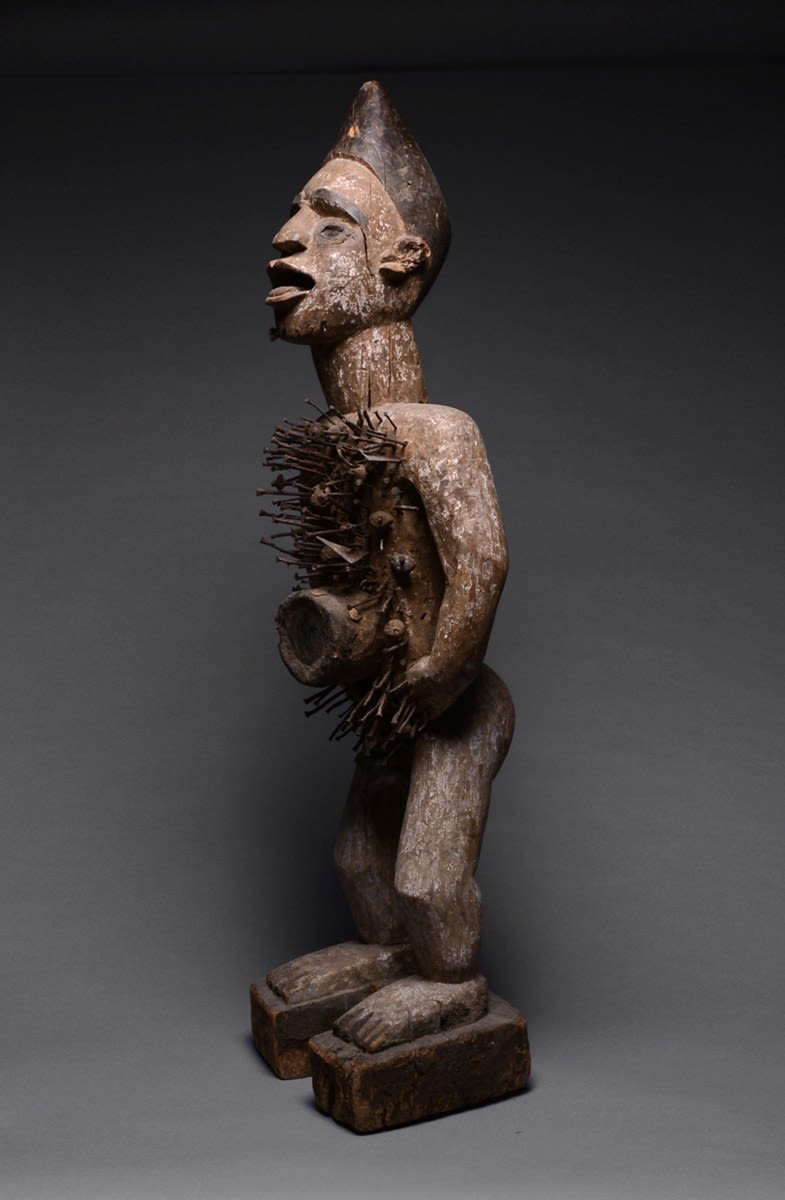Kongo Wooden Nkisi Nkondi Sculpture, 20th Century CE
Wood and Metal
PF.1537
Further images
The Kongo (or Bakongo) people live in the Democratic Republic of the Congo, Angola and the Congo. By the end of the 15th century the Kongo were living in a...
The Kongo (or Bakongo) people live in the Democratic Republic of the Congo, Angola and the Congo. By the end of the 15th century the Kongo were living in a series of loosely-connected yet autonomous kingdoms, to include Kongo, Ngoyo, Vungu and Kakongo, followed by the increasingly powerful Bakongo kingdom, Loango, at the start of the 16th century. This coincided with the arrival of the first Portuguese explorers, with whom they had a reasonably peaceful relationship for some time. The kingdom absorbed European traditions and religion without bloodshed, and, more importantly, with much of their indigenous culture intact. While matters deteriorated subsequently, partly due to wars with other tribal groups (notably the Yaka), the Kongo tribes have survived relatively well as cultural entities and have seen a resurgence since their independence in 1960.
Indigenous Kongo society was based around the kingship model, with extensive arrays of civil servants and court officials not unlike that of the Nigerian Kingdom of Benin. Owing to the large size of the area in which they live, this group is often unable to communicate and has to rely upon French/Portuguese or creoles based upon them. Their religious beliefs have a far wider circulation, and are based around a reverence for the dead who are believed to be able to assist in the determination of future destinies. They are also believed to inhabit minkisi (singular nkisi), or charms, that can be appealed to for assistance in times of duress or uncertainty. The most notable pieces of Kongo sculpture are the Nkisi Nkondi figures – often referred to as nail fetishes – which carry a packet of magical materials known as a bilongo; the figures are insulted and “hurt” with explosions and nails so that they will carry out the wishes of their tormentor. Various other categories also exist, such as the ntadi limestone grave markers and maternity figures with characteristic open-mouths, almond-shaped eyes and detailed surface work.
The Kongo people believe there are innumerable spirits that dwell in nature. Occasionally one inhabits a human being and that person falls ill. In such a case, a healer (magician) must use a nkisi to "lure" the spirit from the human body into the fetish body. The exorcism commences with the patient being covered in red powder, the color of the nkisi spirit, then drinking a potion made of fetish ingredients. If all goes well, the spirit is expelled from the patient's body and fixed inside the nkisi. These remarkable statues are also used as protection and for oath-taking. When one is in use, nails or blades are driven into it to activate its spiritual energy. The nkisis are also referred to as "power figures", and each of the nails or iron blades hammered into them by patients undergoing exorcism, serve as proof of the statues efficacy. Though an object such as a nkisi is very alien to Western culture, we can feel its authority and intensity, which may literally be from beyond the physical world.
Indigenous Kongo society was based around the kingship model, with extensive arrays of civil servants and court officials not unlike that of the Nigerian Kingdom of Benin. Owing to the large size of the area in which they live, this group is often unable to communicate and has to rely upon French/Portuguese or creoles based upon them. Their religious beliefs have a far wider circulation, and are based around a reverence for the dead who are believed to be able to assist in the determination of future destinies. They are also believed to inhabit minkisi (singular nkisi), or charms, that can be appealed to for assistance in times of duress or uncertainty. The most notable pieces of Kongo sculpture are the Nkisi Nkondi figures – often referred to as nail fetishes – which carry a packet of magical materials known as a bilongo; the figures are insulted and “hurt” with explosions and nails so that they will carry out the wishes of their tormentor. Various other categories also exist, such as the ntadi limestone grave markers and maternity figures with characteristic open-mouths, almond-shaped eyes and detailed surface work.
The Kongo people believe there are innumerable spirits that dwell in nature. Occasionally one inhabits a human being and that person falls ill. In such a case, a healer (magician) must use a nkisi to "lure" the spirit from the human body into the fetish body. The exorcism commences with the patient being covered in red powder, the color of the nkisi spirit, then drinking a potion made of fetish ingredients. If all goes well, the spirit is expelled from the patient's body and fixed inside the nkisi. These remarkable statues are also used as protection and for oath-taking. When one is in use, nails or blades are driven into it to activate its spiritual energy. The nkisis are also referred to as "power figures", and each of the nails or iron blades hammered into them by patients undergoing exorcism, serve as proof of the statues efficacy. Though an object such as a nkisi is very alien to Western culture, we can feel its authority and intensity, which may literally be from beyond the physical world.







